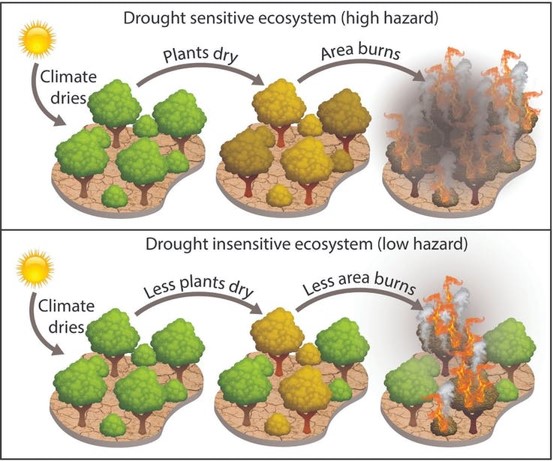Plant-water sensitivity regulates wildfire vulnerability
Published in Nature Ecology & Evolution, 2022
Recommended citation: Rao, K., Williams, A.P., Diffenbaugh N.S., Yebra, M., & Konings, A.G. (2022). Plant-water sensitivity regulates wildfire vulnerability. Nature Ecology & Evolution, 6, 332–339 (2022) https://www.nature.com/articles/s41559-021-01654-2
Extreme wildfires extensively impact human health and the environment. Increasing vapour pressure deficit (VPD) has led to a chronic increase in wildfire area in the western United States, yet some regions have been more affected than others. Here we show that for the same increase in VPD, burned area increases more in regions where vegetation moisture shows greater sensitivity to water limitation (plant-water sensitivity; R2 = 0.71). This has led to rapid increases in human exposure to wildfire risk, both because the population living in areas with high plant-water sensitivity grew 50% faster during 1990–2010 than in other wildland–urban interfaces and because VPD has risen most rapidly in these vulnerable areas. As plant-water sensitivity is strongly linked to wildfire vulnerability, accounting for ecophysiological controls should improve wildfire forecasts. If recent trends in VPD and demographic shifts continue, human wildfire risk will probably continue to increase.

The same amount of dryness can cause different amounts of burned area, depending on how sensitive the trees are to drought.
In the news …
- Stanford researchers identify ‘double-hazard’ zones for wildfire in the West, Stanford News
- The fastest population growth in the West’s wildland fringes is in ecosystems most vulnerable to wildfires, The Conversation
- New Study Shows Effects of Drought on Wildfire Danger, KQED Radio
- Researchers identify ‘double-hazard’ zones where Western wildfires pose increased risk, The Hill
- ‘Double hazards’ map points to a hidden geography of wildfire risk, The Hill
- Plant and soil types linked to increase wildfires in United States, Environment Journal
- “Double-hazard” wildfire zones identified in the American West, Earth.com
- Stanford researchers identify ‘double-hazard’ wildfire zones in the West, ABC News
- Paper featured on the front page of Nature Ecology & Evolution, March 2022 Issue
